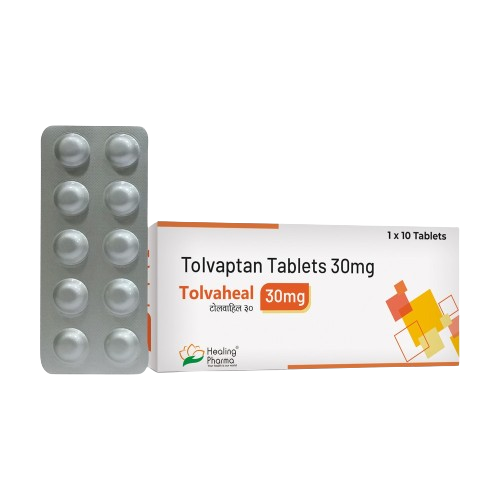Tolvaptan 30 mg Tablets – Complete Guide for Hyponatremia & Polycystic Kidney Disease
🔹What is Tolvaptan 30 mg Used For?
Tolvaptan is an oral vasopressin receptor antagonist used primarily to treat:
- Hyponatremia (low sodium levels) in:
- Syndrome of Inappropriate Antidiuretic Hormone Secretion (SIADH)
- Congestive heart failure
- Cirrhosis-related fluid retention
- Autosomal Dominant Polycystic Kidney Disease (ADPKD)
- To slow kidney function decline and cyst growth
🔹How Tolvaptan Works
Tolvaptan selectively blocks vasopressin V2 receptors in the kidney. This:
- Promotes excretion of free water (aquaresis) without significant electrolyte loss
- Raises serum sodium levels in hyponatremia
- Reduces cyst formation and growth in ADPKD by decreasing cyclic AMP levels in kidney cells
🔹Indications and Dosage
🔸 1. Hyponatremia (Samsca®):
- Starting dose: 15 mg once daily
- Titrated up to: 30–60 mg/day based on response and serum sodium
- Tolvaptan 30 mg may be used after initial dose adjustment
🔸 2. Autosomal Dominant Polycystic Kidney Disease (Jinarc®):
- Initiation typically under specialist care
- Split dose regimen: e.g., 45 mg in the morning + 15 mg evening, titrated up to 90/30 mg (depending on tolerability)
- 30 mg tablets may be used as part of the titration schedule
⚠️ Always under medical supervision with liver monitoring.
🔹Benefits of Tolvaptan 30 mg
- Corrects low sodium effectively in hyponatremic states
- Improves neurologic symptoms of hyponatremia (e.g., confusion, seizures)
- In ADPKD: slows down kidney enlargement and renal function decline
- Oral administration with a once-daily dosing option (for hyponatremia)
🔹How to Take Tolvaptan 30 mg
- Take orally with or without food
- Administer early in the day to minimize nocturnal urination
- Maintain adequate fluid intake to avoid dehydration
- Avoid grapefruit juice, which increases drug levels
🔹Side Effects
✅ Common Side Effects:
- Increased thirst
- Frequent urination
- Dry mouth
- Constipation
- Weakness or fatigue
- Polyuria (increased urine output)
⚠️Serious Side Effects:
- Liver injury (monitor ALT, AST)
- Dehydration or hypotension
- Rapid correction of sodium (can cause osmotic demyelination syndrome)
- Hypernatremia
- Electrolyte imbalances
🔹Liver Monitoring Requirement
- Particularly important in ADPKD treatment
- Monitor liver enzymes (ALT, AST, bilirubin) at:
- Baseline
- Every month for the first 18 months
- Then every 3 months
- Discontinue if signs of drug-induced liver injury appear
🔹Warnings and Precautions
- Do not use in patients who cannot perceive or respond to thirst
- Avoid in hypovolemic hyponatremia
- Use caution in patients with hepatic impairment
- Requires hospital initiation for hyponatremia due to risk of rapid correction
- Avoid in pregnancy and breastfeeding
🔹Drug Interactions
- Strong CYP3A4 inhibitors (e.g., ketoconazole, clarithromycin) ↑ tolvaptan levels
- CYP3A4 inducers (e.g., rifampin, phenytoin) ↓ efficacy
- Diuretics or other nephrotoxic drugs may increase dehydration risk
- Avoid grapefruit products
🔹Storage Instructions
- Store at 20–25°C (68–77°F)
- Keep away from moisture and direct sunlight
- Keep out of reach of children
- Do not use past the expiration date
🔹Patient Tips
- Drink water as instructed to prevent dehydration
- Report any signs of liver trouble (e.g., yellowing of skin, dark urine)
- Do not take more or less than prescribed
- Inform your doctor about all other medications and supplements








Reviews
There are no reviews yet.